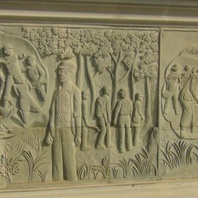
Item
Win-Win Monument bas-relief
This photograph provides a view of bas-relief on the 117-metre-long engraved base of the Win-Win Monument. It depicts the defection to Vietnam of the then Khmer Rouge officer Hun Sen in June 1977. One sees Hun Sen (dressed in Khmer Rouge garb) considering what may happen to him and his group of defectors (being killed) if they are caught by the Khmer Rouge. It also shows Hun Sen thinking about his wife who he left behind. The Win-Win Monument complex – photographed here in January 2020 – was inaugurated in December 2018 to mark the twentieth anniversary of the end of the post-Democratic Kampuchea civil war, with the final defection of the remaining Khmer Rouge factions, thanks to the DIFID policy (“Divide, Isolate, Finish, Integrate, Develop”) also known as the “Win Win” policy of Prime Minister Hun Sen.
Read More
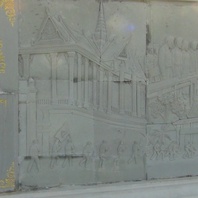
Item
Win-Win Monument bas-relief
The photograph shows a view of bas-relief on the 117-metre-long engraved base of the Win-Win Monument. It depicts the takeover of Phnom Penh in January 1979 by troops from the Kampuchea United Front for National Salvation (FUNSK) and Vietnamese forces. One sees soldiers with a flag of Cambodia passing the Royal Palace. The Win-Win Monument complex – photographed here in January 2020 – was inaugurated in December 2018 to mark the twentieth anniversary of the end of the post-Democratic Kampuchea civil war, with the final defection of the remaining Khmer Rouge factions, thanks to the DIFID policy (“Divide, Isolate, Finish, Integrate, Develop”) also known as the “Win Win” policy of Prime Minister Hun Sen.
Read More
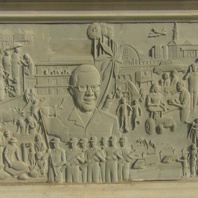
Item
Win-Win Monument bas-relief
This photograph provides a view of the bas-relief on the 117-metre-long engraved base of the Win-Win Monument. It depicts the rebirth of Cambodia after 1979 with different sectors being represented (religion, agriculture, transport, etc.). Hun Sen is featured in the middle, and is larger in sizes than other figures. The Win-Win Monument complex – photographed here in January 2020 – was inaugurated in December 2018 to mark the twentieth anniversary of the end of the post-Democratic Kampuchea civil war, with the final defection of the remaining Khmer Rouge factions, thanks to the DIFID policy (“Divide, Isolate, Finish, Integrate, Develop”) also known as the “Win Win” policy of Prime Minister Hun Sen.
Read More
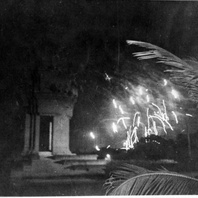
Featured Item
Gunfire near the Independence Monument, Phnom Penh
This image shows firing at night near the Independence Monument during the takeover of Phnom Penh by Vietnamese forces and the troops of the Kampuchea United Front for National Salvation (KUFNS, also known as FUNSK) [Front or Renakse] in January 1979. This photograph is part of the collection held by the Agence Khmère de Presse (AKP) and Cambodia’s Ministry of Information. This collection, which documents the early years of the People’s Republic of Kampuchea as photographed by the Vietnamese and a small team of Cambodian photographers, has not yet been classified or indexed.
Read More
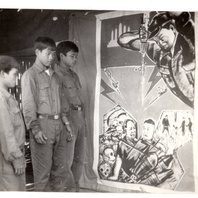
Featured Item
Three men looking at a propaganda poster
This picture shows three young male soldiers looking at a poster that represents a soldier of the Kampuchea United Front for National Salvation (KUFNS, also known as FUNSK) [Front or Renakse] aiming his rifle with bayonet at the enemies, Pol Pot and Ieng Sary. The drawing next to Pol Pot’s head is a reproduction of a photograph of killings by Khmer Rouge guards that were published between April 1976 and January 1978 in the mainstream Western media. Different stories circulated about the origin of those pictures. Some said they had been smuggled out of Cambodia by a relative of the photographer, who himself had died while trying to escape, or by a Cambodian refugee in Paris who refused to reveal his identity. According to Sygma Photo News (the agency which had distributed the original pictures), the images came from Khmer Rouge defectors. In fact, the photos had first appeared in a Thai newspaper in April 1976 and were reprinted in the Bangkok Post under the headline “True or false?” a few days later. The newspaper explained that they had first refused to buy the images from the Thai trader who tried to sell them because they had doubted their authenticity. Even American intelligence services thought the pictures were fake. The photographs, it turned out, were part of an operation by the Thai intelligence services. They had been staged and taken in Thailand. This photograph is part of the collection held by the Agence Khmère de Presse (AKP) and Cambodia’s Ministry of Information. This collection, which documents the early years of the People’s Republic of Kampuchea as photographed by the Vietnamese and a small team of Cambodian photographers, has not yet been classified or indexed.
Read More
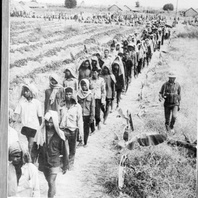
Featured Item
Khmer Rouge prisoners escorted by Vietnamese troops
This picture shows Khmer Rouge prisoners being escorted by Vietnamese soldiers during the start of the Vietnamese intervention in Cambodia. This photograph is part of the collection held by the Agence Khmère de Presse (AKP) and Cambodia’s Ministry of Information. This collection, which documents the early years of the People’s Republic of Kampuchea as photographed by the Vietnamese and a small team of Cambodian photographers, has not yet been classified or indexed.